Several of my tango students who prefer to only dance as followers, harbor trauma from their initial group tango classes. They feel the new leaders dragged them around and expected them to guess what move should be done, but they were not taught how to follow. On top of that, they paid as much as the leaders, but did not feel the teacher instructed them, except to help the leaders feel good about themselves. I know that is not everyone’s experience, but if you are feeling frustrated in a class that seems to ignore the followers, I have some pro-active suggestions.
Lead!
For those of you open to leading, learning to both lead and follow is the best way to learn tango. That way, you have a more holistic view of the dance. In addition, in a leader-info-heavy class, you can use all the information taught in the class and you will remember it better than someone only leading or only following. On a deep level, trying to lead something makes you understand what the leader needs from the follower AND what the follower needs from the leader to be successful. You also gain the added bonus: you can recognize when you ARE following exactly what the leader led and stand up for yourself if you hear the “why aren’t you doing what I led” reproach.
I like to lead and follow for several reasons. First, I learned all my couple dances this way. The group of dancers available when I learned to dance at Carleton College was small, and we needed everyone to contribute. We all danced both parts. I have continued to learn and teach that way, whenever possible. Second, I feel strongly that doing both parts allows you to dance when you want. When your favorite song plays and none of your favorite leaders are available, YOU can grab a friend and lead. The leads to a less competitive attitude between followers in a community and to more friendships: two positive points!
Focus on your own technique
If you do not want to lead, that’s fine. Perhaps you lead enough in your off-the-dance-floor life that you just want to melt into someone’s arms and NOT lead; this calls for a different approach.
Group class is the perfect time to practice your technique. Most people learn technique in private lessons and practice with others at group classes. Your teacher knows what you are working on in individual lessons and can guide you in the group class to apply your knowledge to various situations that arise. It’s Tango Princess time, no matter what gender you subscribe to: work on looking good, dancing well, expressing yourself musically—and if the leader leads the move, it will happen. If the leader does not lead the move, that is not your problem! Articulate through your feet, maintain your axis, breathe, practice adjusting your embrace to work well from person to person: these are the deep, subtle skills of tango, not the moves!
Learn by peer teaching
One of the best ways to solidify your own knowledge about tango is to peer teach. If a dancer unused to following and you are not used to leading (or if they are much bigger than you are), it can be daunting to lead someone to show them how their lead feels to you or what is not working. However, if you can describe what needs to happen, you will find you understand the move much better yourself.
Find ways to help the leaders understand the move from the follower’s point of view! Every single person I interviewed for my thesis on leading and following in Argentine Tango in Buenos Aires said the SAME thing: “Make the follower feel secure so that they will feel comfortable and let themselves be led.” The leader wants you to feel comfortable and happy, despite complaining that you aren’t doing the move. Remind them that leading as difficult as following, and that it takes time to get it right.
Plus, a leader who has suddenly gained understanding of a move so that it works, can express gratitude and you will feel great for helping create a leader who will (later) both dance better and remember your help.
In defense of move-driven classes
Last week I taught a class that was larger than usual. Dancers ranged from complete beginners to 10-15 years of experience. On top of that, most of the women in the class were working on lead and follow. Some of the men were also switching roles (not all happily, but I appreciated their willingness to try!). Normally, I spend at least half of my class on general technique and follower technique because I know most classes do not. However, with such chaos (and so many tentative new leaders in the mix), I talked more about leading. The few people who were not leading at all, got the short end of the stick. Don’t judge a teacher or a class from one interaction on one night: if you see an ongoing pattern that does not work for you, tell the teacher. If there is no response/change, try my tips above and/or find a new class!
And to my students who came to me with years of trauma from group classes that ignored them as followers (one described herself as a tango robot doll), keep dancing as you heal emotionally!
